Analysis of Office-Teaching Comprehensive Buildings Using a Modified Seismic Performance Evaluation Method
Hanbo Zhu , Changqing Miao , and Meiling Zhuang
Abstract: Current building design codes allow the appearance of structural and nonstructural damage under design basis earthquakes. The research regarding probabilistic seismic loss estimation in domestic building structure is urgent. The evaluation in this paper is based on a 11-story reinforced concrete office building,incremental dynamic analysis (IDA) is conducted in Perform 3D program using models capable to simulate all possible limit states up to collapse. Next, the probability distribution of post-earthquake casualties, rebuild costs repair costs and business downtime loss are calculated in PACT software for the studied building considering the modified component vulnerability groups and population flow models. The evaluation procedure can also shed light on other types of buildings in China. For non-typical functional building structures, this article proposes to build a finite element model of structural components and to classify the vulnerability groups based on the construction drawings, and to supply and improve the vulnerability library of appendages in FEMA P-58 according to the actual situation. In this way, the application scope of building seismic performance evaluation can be expanded.
Keywords: A modified seismic capacity assessment method, frame-shear wall structure,incremental dynamic analysis (IDA), seismic performance assessment analysis software(PACT).
1 Introduction
In the middle of the 1980s, the performance assessment method began to proposed in the United States [Council, Rojahn, Shapiro et al. (2000); Council, Rojahn, Moehle et al.(1997)], and until 2012, this approach tends to become perfect [Hamburger, Bachman,Heintz et al. (2011a); Hamburger, Bachman, Heintz et al. (2011b)], but is only suitable for Northern California in the USA because of specific seismic intensity scale,component vulnerability groups, population flow models and so on. After over 50 years’accumulation of rapid urbanization in the world, a large number of existing buildings come to the middle and late stages of their working life, and it is necessary to provide precise quantitative assessment index and method system in terms of safety, economy,applicability and so on, regardless of its transaction, maintenance and reinforcement,restoration or reconstruction. The performance-based seismic performance assessment method adopts the performance indicators that can be understood by owners, users,investors and other stakeholders of building. It is convenient for all relative people to make a quick and comprehensive decision together in repair and strengthening of damaged existing buildings. At present, there are two ways to evaluate the seismic performance of existing buildings: (1) take the vulnerability of the whole structure as the basis of seismic performance assessment; (2) take the vulnerability of component groups as the basis of seismic performance assessment. The first way is the Mainstream approach on the seismic capacity assessment of buildings, and some achievements have been made. Seo et al. [Seo, Karavasilis, Ricles et al. (2015)] provide a simplified design procedure the seismic performance of steel moment resisting frames (MRFs) with supplemental fluid viscous dampers against collapse, IDA and fragility methodology has been applied. Vecchio et al. [Vecchio, Ludovico, Prota et al. (2016)] provide a new modelling strategy has been developed to account for the joint nonlinear behavior and the fiber reinforced polymer (FRP) strengthening in the finite element method (FEM). At the structure level, the benefits of the joint FRP strengthening on the global seismic performances were numerically [Liu (2016)] provide a structural damage assessment method with the equal energy index, a performance measure (PM); this method can effectively improve the seismic performance of reinforced concrete frame shear structures. Shokrabadi et al. [Shokrabadi and Burton (2018)] proposed a Markov risk assessment framework for developing aftershock damage fragility curves for RC frames.The focus of this paper is placed on quantifying the impact of both the elevated post-mainshock seismic hazard as well as the mainshock-induced structural damage on the seismic risk of three reinforced concrete moment frame. The substantial contribution of aftershocks to the collapse risk in the pre-mainshock environment highlights the need for a design procedure that accounts for the additional seismic risk from aftershocks. The guidelines provided by Cosenza et al. [Cosenza, Vecchio, Ludovico et al. (2018)] are very simple and allow practitioners to deal with expected annual losses (EAL) and repair costs(expressed as a fraction of the Reconstruction Cost: %RC). The seismic risk classes of buildings and the class upgrade due to strengthening interventions can be assessed using the principles included in the guidelines. Simple tool based on the principles is provided to estimate the cost of the strengthening interventions and improve the seismic capacity at the life-safety limit states. But there exist three disadvantages including the subjective and rough seismic performance indexes, poor and ambiguous calculations and insufficient consideration of nonstructural components and contents. The second way is to combine two kinds of vulnerability to evaluate the seismic capacity of buildings. In the United States, a framework of performance-based earthquake engineering methodology for buildings and bridges has been developed by Vona [Vona (2001)], ATC-58 (2002)report and FEMA P-58 (2012) report and related achievements have been published by FEMA (Federal Emergency Management Agency) through the recently ten years efforts,marking a new generation of seismic capacity assessment method tending to be perfect in the United States, but in other country, the use of this assessment method has just getting started. By simplifying the above assessment method, some scholars have made some achievements for seismic performance assessment from the damage vulnerability of component groups in the buildings. Mosallam et al. [Mosallam, Zirakian, Abdelaal et al.(2018)] presents a probabilistic study using the fragility function method for the performance assessment of two 1/6-scale, single-bay, three- and eight-story steel moment-resisting frame structures representing rigid and flexible framed structures,respectively. Considering the impact of the uncertainties in seismic loading and response of structures, the adopted fragility methodology is believed to provide a realistic and robust assessment of seismic performance and vulnerability of the structures. Cui [Cui(2014)] provide a seismic performance assessment methodology based on the peak story drift angle; four indexes are obtained which are expected annual mean loss, annual mortality rate, annual injury rate and collapse margin ratio (CMR), Farsangi et al.[Farsangi, Rezvani and Talebi (2014)] also developed fragility curves on the basis of response data from nonlinear incremental dynamic analyses and estimated the seismic fragility and mean annual loss of steel moment-resisting frame buildings in a highly seismic-prone area in Iran. But the performance evaluation method failure to make full use of advanced Component vulnerability library in the United States and evaluate seismic performance of comprehensive buildings.
In this article, the seismic performance assessment process of FEMA P-58 taken as a framework, combined with the characteristics of domestic building structure and specification requirements, based on the probability theory of a modified seismic capacity assessment of buildings. for an individual building, the seismic performance is evaluated by the finite element analysis model based on PERFORM 3D and seismic economic performance assessment model based on PACT. Finally, the probability distribution of restoration costs, restoration time, the number of injuries and deaths at different earthquake intensities is obtained.
2 The modified seismic performance evaluation method based on seismic intensity
A modified seismic performance evaluation method can be used to develop three types of performance assessment: intensity-based, scenario-based, and time-based assessments.The first type is mainly discussed in detail.
2.1 Seismic performance evaluation method based on intensity
Intensity-based assessment is based on the specific ground motion intensity (e.g., defined by the elastic acceleration response spectrum with 5% damped) to determine the probability distribution of building seismic performance index (casualties, repairs or reconstruction costs, residence interruption time, etc.).
The two main problems can be mainly solved by: 1) the average repair cost, in present dollars, and The probability of it exceed a certain value (e.g., 1 million dollars) necessary to restore a building to its pre-earthquake condition in the seismic basic intensity; 2) the mean repair time, in hours, necessary to restore or reconstruction a building to its health state in the large earthquake.
The above method can generally be used in areas where the seismic intensity can be accurately measured (such as some large and medium-sized cities), the seismic intensity index can be accurately obtained, before the earthquake, the performance function under the horizontal earthquake action can be obtained, which is easy to estimate the damaged structure performance rapidly after the event and provide the preliminary basis for the rapid decision-making of each department.
2.2 Operation flow of seismic performance evaluation method based on seismic intensity
The seismic performance evaluation flows of buildings based on seismic intensity are as follows:
1. The finite element model of buildings is established.
2. The performance demand parameters under the horizontal earthquake action can be obtained by conducting the incremental dynamic analysis on the model.
3. The vulnerability function of building collapse structure is established based on the overall seismic performance.
4. The personnel mobility model of building and component vulnerability grouping is established.
5. The structural vulnerability function of a building is established based on the component vulnerability groups.
6. The performance function (including the probability distribution of casualties, repair or reconstruction cost, time of living interruption, etc.) under different seismic intensity is calculated.
The specific evaluation flow is shown in Fig. 1.
3 The collapse vulnerability function of building structure
3.1 Project overview
An office-teaching comprehensive building has plan dimensions of 40 m by 165 m. The building is a 10-story reinforced concrete frame-shear wall structure with comprehensive occupancy located in Xi’an, Shaanxi Province Central China. The layout structure is shown in Fig. 2, and the shaded region represents the shear wall. Floor-to-floor height is 4.5 m on the First floor and 3.6 m on other floors, the total height is approximately 36.9 m. Design basic earthquake acceleration is 0.2 g, the structure is in 8 degrees seismic region according to Chinese Code for Seismic Design of Buildings.
Beams and plates are made of C25 concrete, columns and shear walls are made of C30 concrete. Stirrups and structural steel bars in Beams and plates and distributed steel bars in shear wall both are HPB235. the longitudinal force steel bars are HRB335. The infill wall is made of aerated concrete block with the size ofand M5 cement mortar. The enclosure wall is made of hollow brick with the size ofand M5 cement mortar.

Figure 2: Layout of structure
3.2 Frame-shear wall structure finite element model
The FEM of Frame-shear wall structure is established by SAP2000. The structure geometry information is analyzed by Perform 3D [Liu (2014)]. Based on the section and the material levels, the structural nonlinearity is defined as following:
3.2.1 The model in section level
The plastic zone model is selected for Beam and column unit. The layer model is selected for beam plastic zone section and the fiber model is selected for the column plastic zone section, which indicates the bending nonlinearity of beam and column. The fiber model is selected for shear wall section, which indicates the bending nonlinearity of shear wall. In the same time, the overall shear model is used to indicate the shear nonlinearity in all kinds of components including beam, column and shear wall. The fiber model of shear wall unit is shown in Fig. 3.
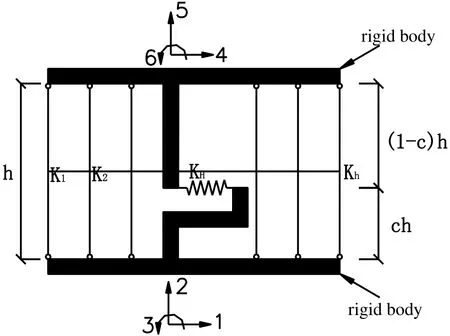
Figure 3: The fiber model of shear wall unit
3.2.2 The model in material level
The constitutive relationship of the steel bar and the non-constrained concrete is calculated according to Code for Design of Concrete Structures in China [Zhao, Xu and Hua (2015)] and fitted respectively by the four-line and five-line models in the PERFORM 3D, the average of the yield strength of reinforcement and the uniaxial compressive strength of concrete are used. The confined concrete compressive stress-strain relationship is fitted by the five-line according to the modified Kent-Park model [Mander, Priestley and Park (1988); Mola and Pellegrini (2012)], as shown in Fig.4. Top force-displacement shear nonlinear relationship of shear wall (Fig. 5) is calculated by using the Hirosawa formula [Kolozvari, Orakcal and Wallace (2014)].
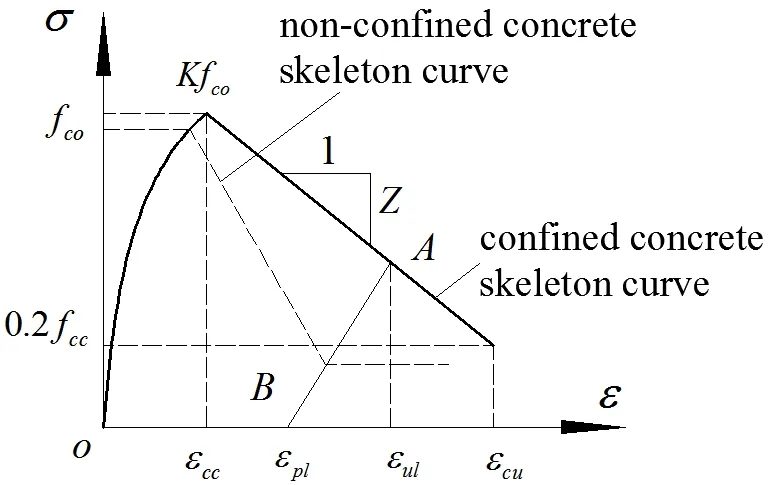
Figure 4: The modified Kent-Park concrete model curve
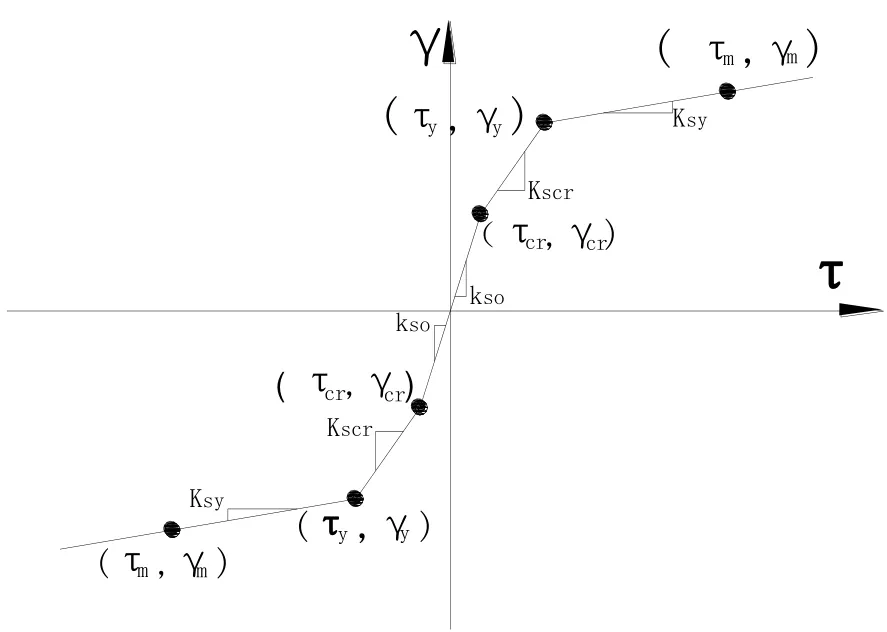
Figure 5: Parameter of the shear wall skeleton curve
3.3 Structure response analysis
The response spectrum acceleration Sa(T) corresponding to the basic natural period of structure vibration is selected as the Ground Motion Intensity Indices (IM). PGA represents the peak ground acceleration. According to the elastic acceleration response spectrum of China’s Code for Seismic Design of Building [Huang, Wang and Dai (2016)],structure vibration acceleration magnification factor can be derived from Eq. (1).

The peak story drift angle is selected as Engineering Demand Parameter (EDP). In the RC frame-shear wall structure, the shear wall structure is the main lateral force resisting member. When the shear wall is completely destroyed, the structure is regarded as being collapse condition. The peak story drift angle of the collapsed state is 3.6% [Hamburger,Bachman, Heintz et al. (2011a)].
3.4 Structural vulnerability analysis of collapsed state
A total of 44 horizontal seismic waves are selected from 22 pairs of far-field strong-motion records provided in FEMA P695 [Washington (2000)]. When the most story drift angle reaches 3.6%, the structure reached the state of collapse. The number of longitudinal shear walls of the building is less than that of transverse shear walls.According to structure modal analysis, the first mode is in the transverse direction.Therefore, the main collapsing form is defined as the overall collapse in the transverse direction, and the result of IDA analysis in the transverse direction is shown in Fig. 6.The structural vulnerability curves corresponding to the collapsed state are obtained by the statistical analysis. The two parameters of the collapse vulnerability curve are fitted by the logarithmic normal distribution: the mean and the mean square deviation of PGA are 2.5 and 0.5, respectively. As shown in Fig. 7, is given by, the mean and the mean squared error ofrespectively are 2.35 and 0.5, respectively.
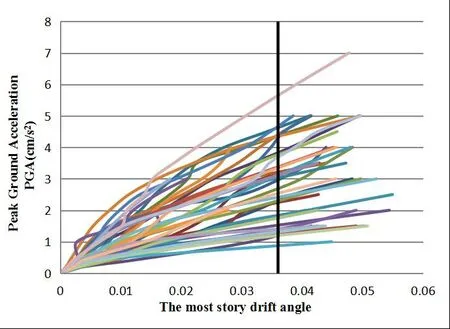
Figure 6: IDA curve distribution

Figure 7: Structure collapse fragility curve
4 Personnel flow models and component vulnerability groups
The personnel flow models and the component vulnerability groups are the two important sections in the seismic performance evaluation of the structure. The two sections in the FEMA P-58 are established on the background of the earthquake disaster data of the North California in America. The above case in China are different from in the North California at the aspects of building types, the personnel flow models, component vulnerability groups, component quantities and so on.
The building in the case is evaluated by Seismic performance evaluation method of a single building in FEMA P-58. The personal flow models and the component vulnerability groups need to be modified, supplied and completed according combining China’s code and national situation.
4.1 The personnel flow model
The personnel flow model is the prediction model of the changes of the number of people with time in different buildings, consisting of two parts as following: the peak population,which is this peak population numbers likely to be present at times of peak occupancy,and the variation proportion of this peak population by time of day, day of the week(weekdays versus weekends) and month of the year. The first part could be obtained through the following ways: (1) the long term actual statistical results; (2) the specifications and local regulations in China, such as architectural design quota of china and enterprises, etc. (3) social rules and common sense of life. The second part could be modified and supplied based on the actual situation in China.
For this case, the performance of the office-teaching comprehensive building can be classified as following: the occupancy of the first, the seventh, the eighth and the tenth floors is office; the twice, third, fourth and ninth floors are occupied by common classrooms, the occupancy of the fifth and sixth floors is multimedia classroom. The multimedia classroom can be taken as an example, the personnel flow model of the teaching building in FEMA P-58 should be modified by the teaching schedule and the actual population flow situation [Song (2017)]. The peak population and the variation proportion of this peak population should be calculated by the actual classroom occupancy rates, seats, course arrangement and other specific information. Fig. 8 and Fig.9 illustrate the calculation results.
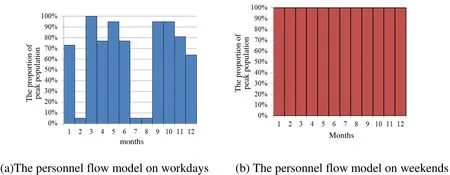
Figure 8: The personnel flow model by month of the year for the occupancy of multimedia classroom
According to the statistical data of the multimedia classroom service condition shows that there are 1100 computers. In a year, the sum occupancy time of all computers is up to 100 thousand hours, the occupancy rate of the multimedia classrooms in the morning higher than in the afternoon, and the multimedia classroom is closed at night, on weekends and holiday.The proportion of the peak population in the morning, noon and evening are 100%, 50%and 0%, respectively. The median peak population is 9.6 people /100 m2, the dispersion is 0.2 [Hamburger, Bachman, Heintz et al. (2011a)].
On the basis of the 3 ways above, the personnel flow model of day for office occupancies is shown in Fig. 10. The first, eighth and tenth floors are occupied by senior offices where the median and dispersion of this peak population are 11.4 people /100 m2and 0.2,respectively and the occupancy of the seventh floor is common office, for which the median and dispersion respectively are 21.2 people /100 m2.
The personnel flow model of day for common occupancies is shown in Fig. 11. For classroom occupancies, the median of the peak number in population model is 22 people/100m2, and the dispersion is 0.2.
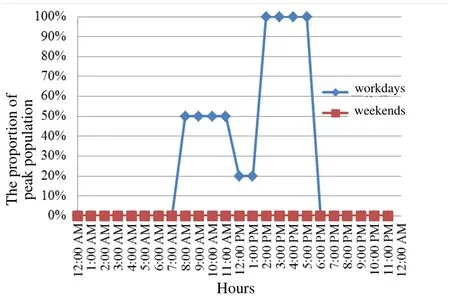
Figure 9: The personnel flow model by time of day for the occupancy of multimedia classroom
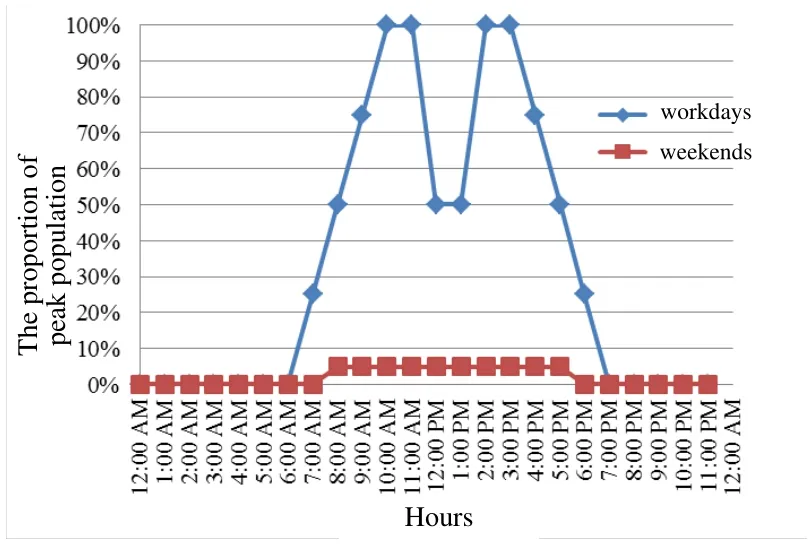
Figure 10: The personnel flow model by time of day for the occupancy of office
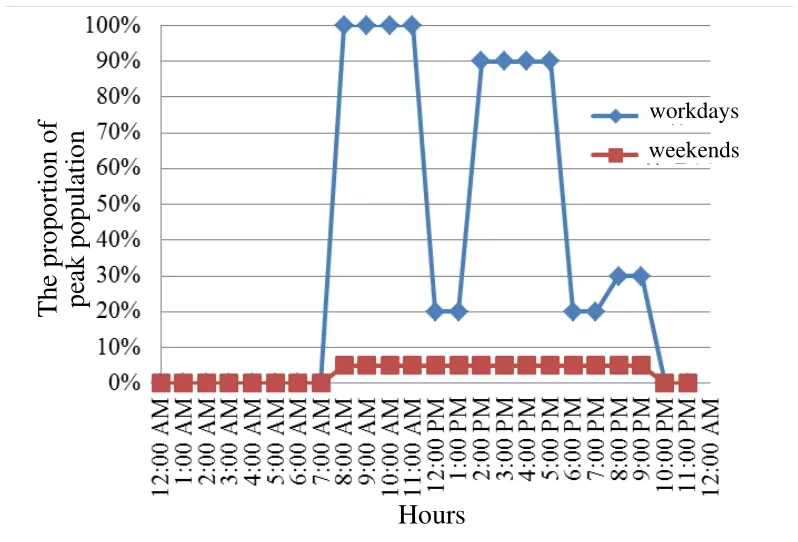
Figure 11: The personnel flow model by time of day for the occupancy of classroom
4.2 The classification of vulnerability groups
There exist three primary kinds of components including structural component (beams,columns, shear walls etc.), nonstructural components (partition walls, roof boarding and floor slabs etc.) and contents (lighting, piping and computers etc.), which are categorized into vulnerability groups and performance groups according to different construction characteristics (details of construction, manufacture and installation techniques), potential damage modes, probabilities of incurring these damage modes being subjected to earthquake demands and potential consequences resulting from damage [Lu, Yu, Wang et al. (2014)].
4.2.1 The classification of the component vulnerability
For certain categories of buildings, the results of vulnerability database from FEMA P-58-2 need to be supplied or modified at the aspects of structural and nonstructural components and contents.
According to the FEMA-58-2 Tabs. 2-3 Fragility Groups in PACT, the component classification of the building is selected, supplied or modified combined with the design of the building [Randall (2013)]. In this case, component vulnerability groups are shown in Tab. 1.

Table 1: Component fragility groups

?
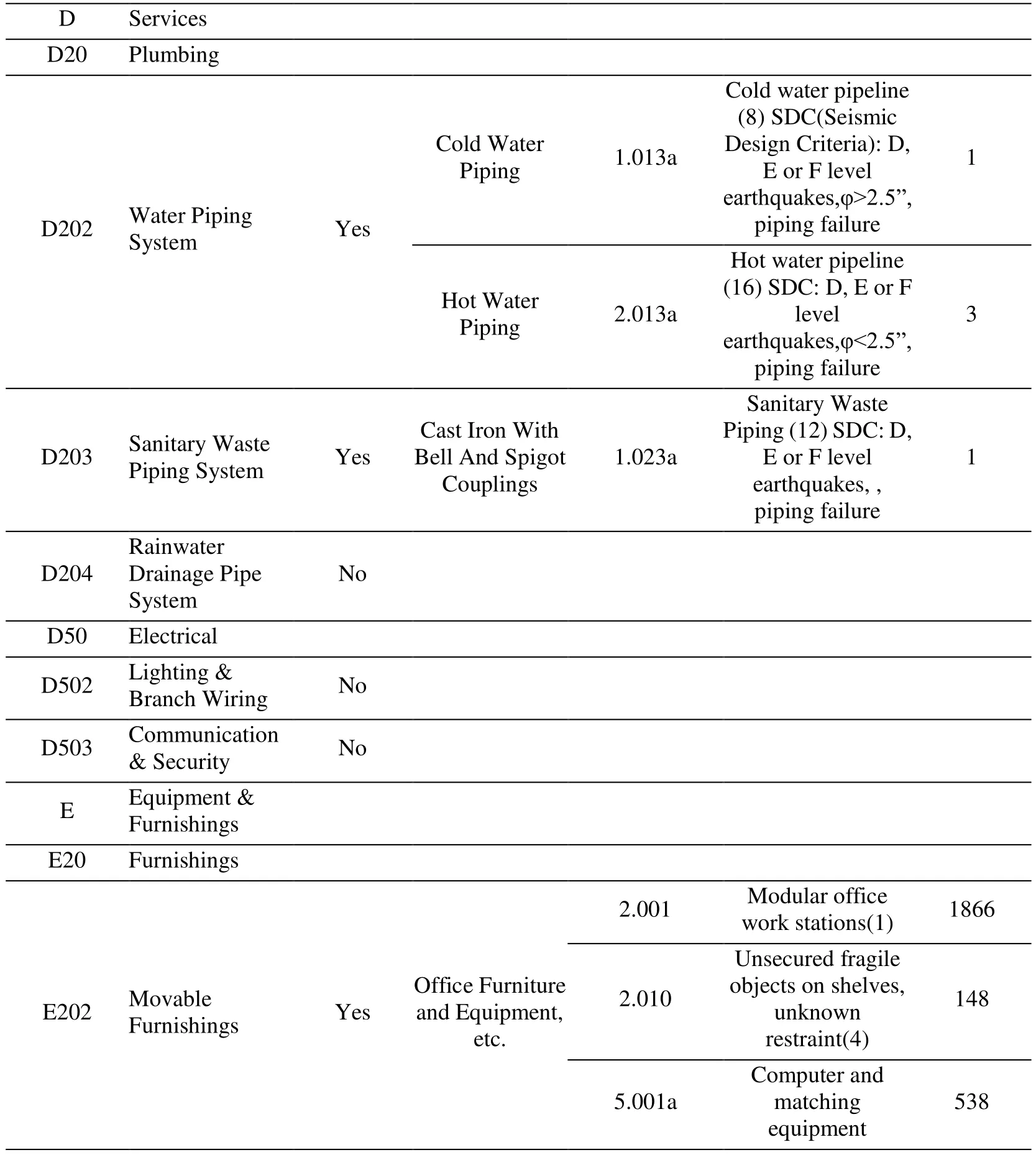
Notes: ① The middle seismic intensity level in SDC2013 code is approximately equal to seismic fortification level of 7 to 8 degrees in GB50011-2010 code. In accordance with the provisions of SDC2013, IBC2006 and other standards, the ductility grades of the special and intermediate levels in SDC2013 code should be chosen as the first and second level.Combined with the case above, the structural frame should be designed in the intermediate ductility grade, and the shear wall should be designed in the special grade ductility grade.② The floor and roof plate of the frame-shear wall structure are too strong without damage. ③ The Reinforced Masonry Wall and Partition Wall is designed in the ductility grades of the special level in order to ensure safety in strong earthquake ground motion.
4.2.2 The component performance groups
The component performance groups are subdivided in the classifications of the component vulnerability. According to the different seismic response in different positions and orientations of the building, the components are in different failure states.Essentially, components in a vulnerability group have approximately damage states under seismic loading. The components are different under different direction and location of the floors. In essence, the different components are represented as different damage states based on the component level. There are too many factors that cause different response based on component level in an earthquake, so the floor is the only factor considered in classification of performance groups to define the subset of vulnerability grouping. On the basis of the vulnerability curve, the EDPs (inter-story displacement angle and floor acceleration peak value) are different in a series of performance groups.
4.2.3 Quantity statistics methods on performance groups
Normative Quantity Database is established on statistical data of 3000 buildings in fact,which occupied by a number of components and contents per unit area. Normative quantity values for 10th, 50th, and 90th percentile quantities were developed based on data from surveys of 3,000 typical buildings across various occupancies in FEMA P-58.Buildings of similar type and occupancy were reviewed during the development of this tools, the quantity of each component per occupancy type is bracketed into 10th, 50th,and 90th percentiles.
Two ways can be used to assess the number of building occupancies in fact. It can be illustrated as follow:
Firstly, based on the structural working drawings of foundation, the main structure,constructional decoration, constructional roofing, constructional heating and drainage,building electricity), the occupancies can be counted. In this method, it has a high calculation accuracy, but it is hard to carry out with this complex operation process. It is suitable for the occupancy types of buildings which the complete construction data is remained in detail.
Secondly, corresponding to the 8 typical occupancy types of buildings which are given by FEMA P-58, for the comprehensive building, there exist several kinds of occupancy types in different proportions. It has a low calculation accuracy in a short period of time. It is suitable for buildings with insufficient construction data in detail.
In this case, the building could be divided into three occupancy types, and the quantity of components are calculated by the two ways above, the typical occupancy types of buildings in FEMA P-58 and field survey combined with the structural working drawings in fact. The statistical methods are shown in Tab. 2.

Table 2: Quantity statistics method on performance groups
5 Seismic performance evaluation of buildings based on earthquake intensity
Based on the modified personnel flow models and component vulnerability groups functions, it can be obtained vectors of Engineering Demand Parameters (EDP) under each seismic intensities of the buildings through IDA analysis method. The same probability of structural response vectors is assumed under the same seismic intensity. A large amount of EDP vectors are selected randomly to input, calculate and sum up and finally obtain the distribution of repair costs, repair time and casualties of buildings under various earthquake intensities. The PACT software (FEMA P-58-3) can be achieve seismic performance evaluation for this office-teaching comprehensive building based on intensity in china according to the occupancy of building in fact.
According to the basic intensity of seismic design in china, seismic performance evaluation of the building is accomplished in specific intensity with a 10% exceeding probability in the future 50 years as follows.
5.1 Results analysis of repair cost
As shown in Fig. 12, a vulnerability curve for building repair costs is provided by the PACT Software. The graph depicts the loss curve for cost associated with the 2 intensity level for all performance groups. The probability of the repair cost less than $211,427 is 50%, the probability of the repair cost less than $420,000 is 90%. The median repair cost is $181,250, reaching 1% of the reconstruction cost.
The bar chart depicts the distribution of losses among various performance groups represented by a histogram of different colors, which shows the composition of the repair costs in an event that has a probability of 50% in Fig. 13, respectively. As shown in Tab.3, loss of Performance groups consists of 5 parts. Among them, except for structural components, loss of computer and other multimedia devices as a kind of content account for 21.04% of the total loss. In the other hand, the damage of partition walls is the most serious at the time of the earthquake. The loss is more than a half of the total loss, and it indicates these are important energy-consuming components in the seismic effort.
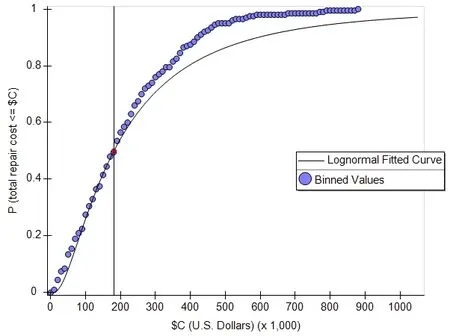
Figure 12: The curve distribution of repair cost
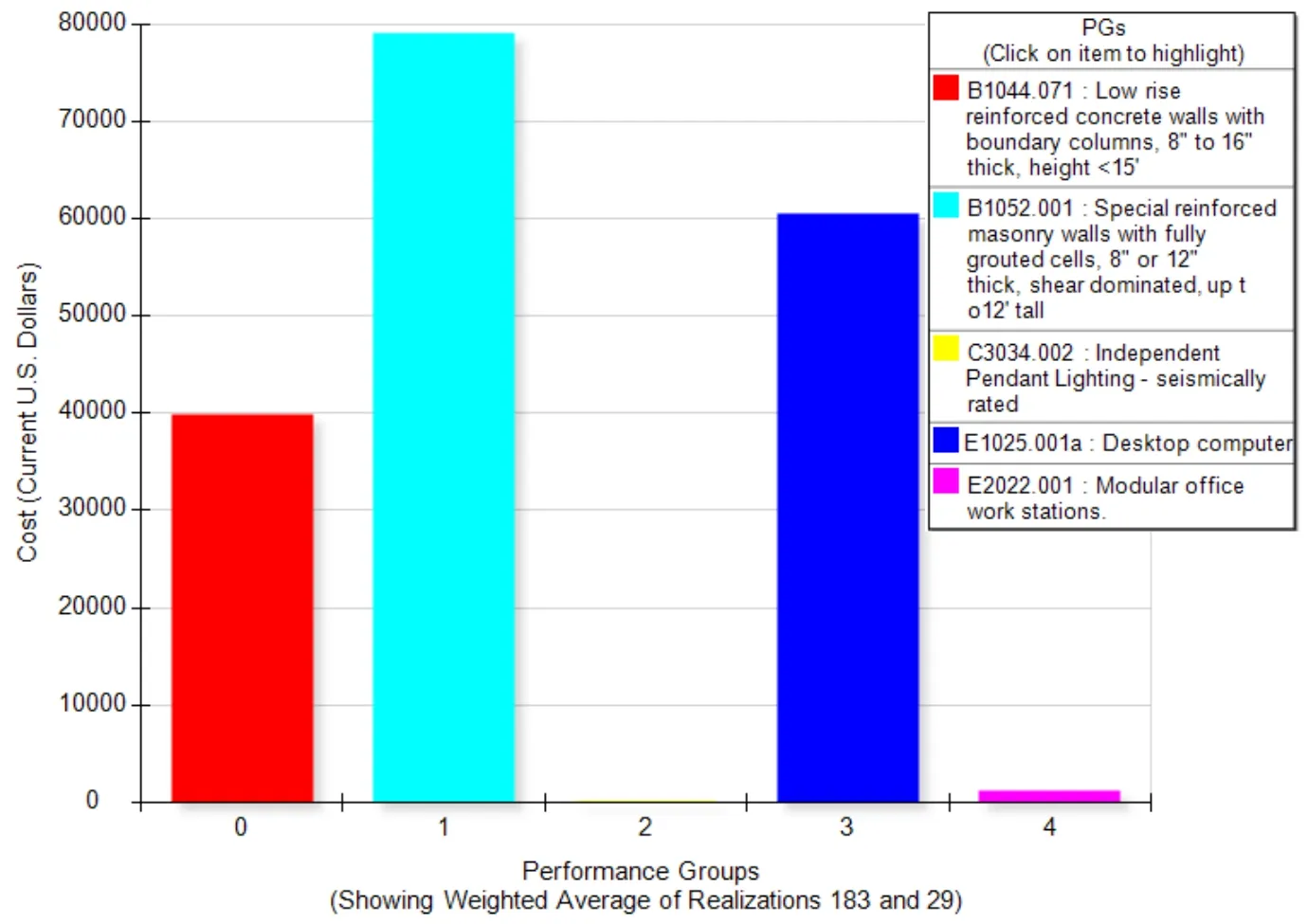
Figure 13: The bar chart on the composition of the repair costs with a 50% probability
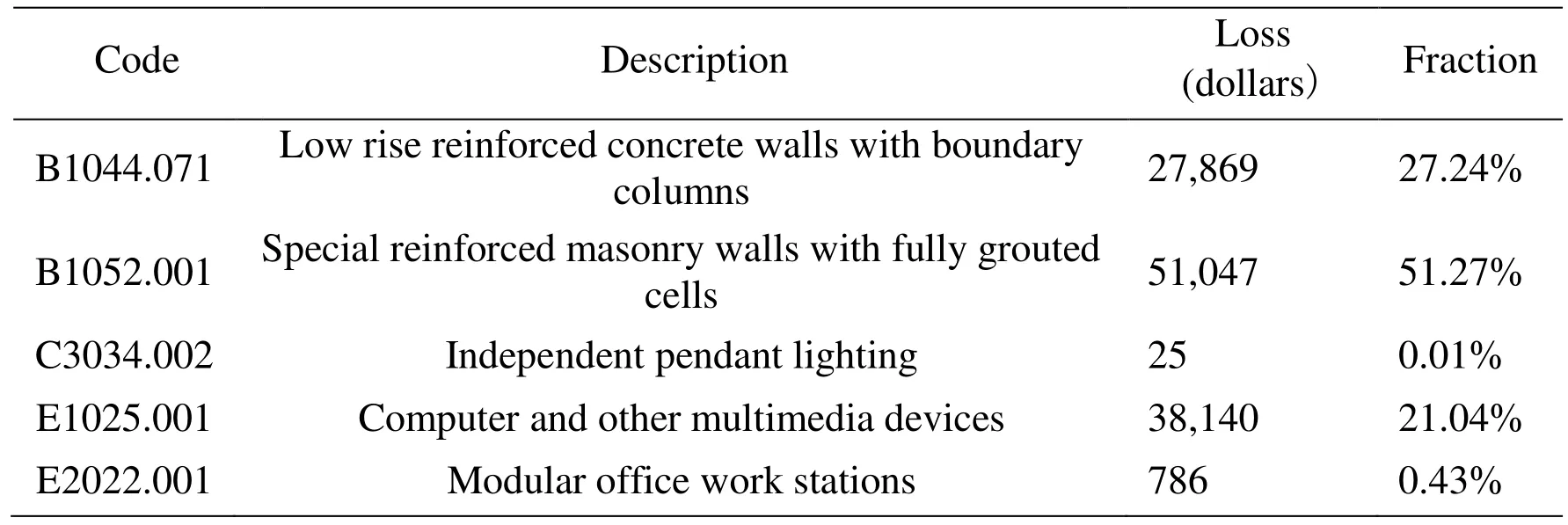
Table 3: Loss of performance groups
5.2 Results analysis of repair time
In Fig. 14 and Fig. 15, the graph shows the repair time probability and the chart shows the total repair time and compositions of each performance group to the total repair time.As is shown in the Fig. 14, the probability of the repair time more than 5.75 days is 50%,and more than 16.1 days is 10%. The median repair time is 7.31 days, reaching 1% of the reconstruction time.
Fig. 14 shows that the repair time of 6th and 7th floors is significantly higher than others with a 50% probability. in the histogram respectively representing the composition of performance groups in 6th and 7th floors, the part of structure is in the severe damage state.
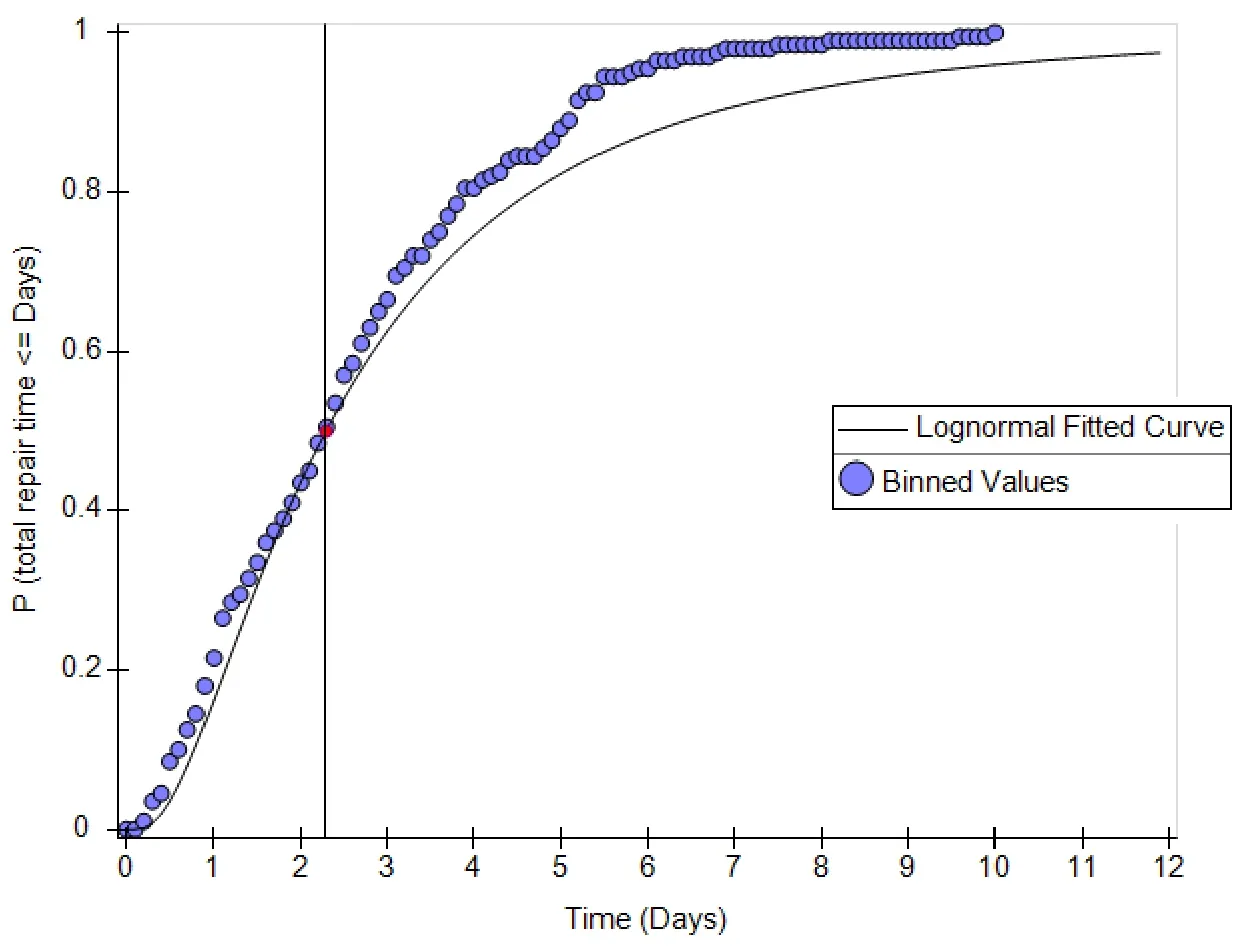
Figure 14: The curve distribution of repair time
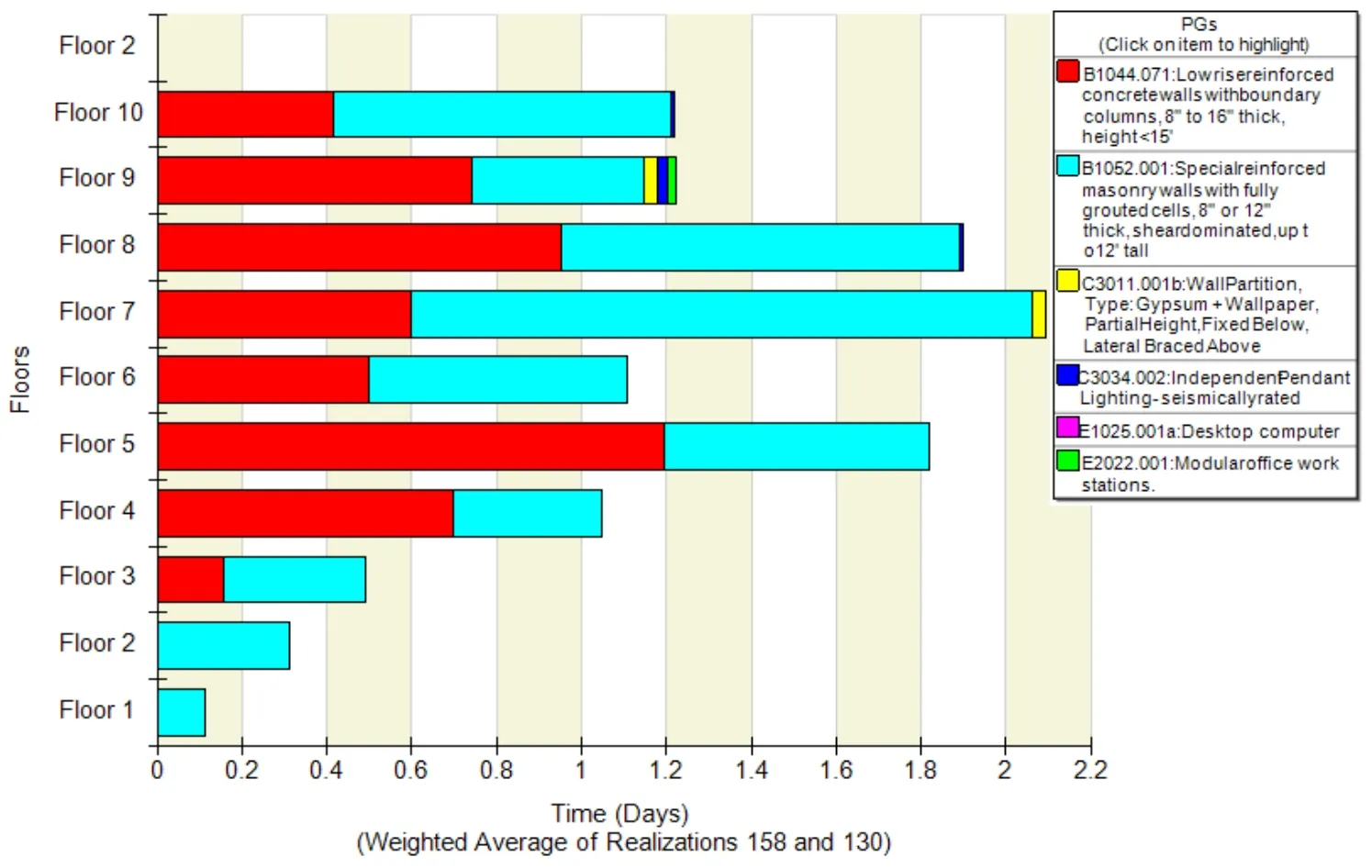
Figure 15: The bar chart on the composition of the repair time with a 50% probability
5.3 casualties results analysis
Fig. 16 shows of the distribution function of injuries and deaths, the average number of them is both 0.
According to the peak value of acceleration response spectra of fundamental natural period Sa(T), earthquake intensities are classified into 7 earthquake intensity levels, the first three intensity levels (level 1, 2 and 3) respectively represent small, medium and large earthquake in Chinese code, and illustrated in Tab. 4.
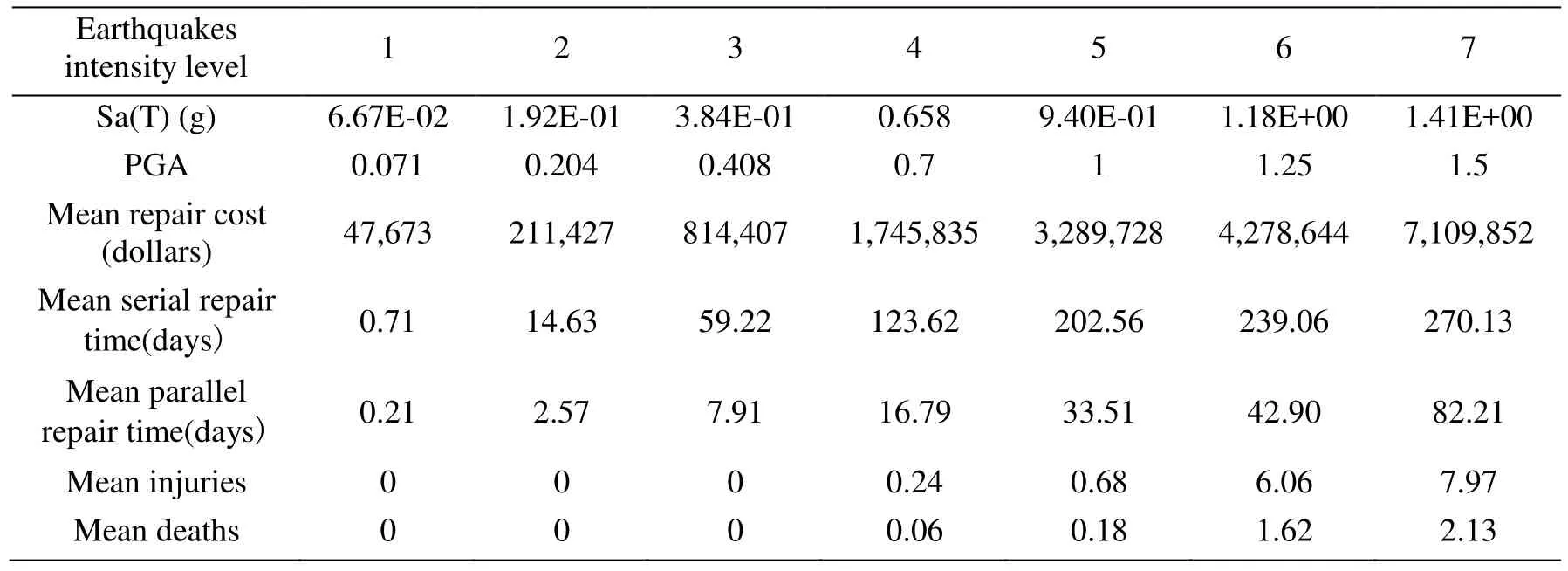
Table 4: Seismic performance assessment of the building
6 Conclusion
The main aim of the paper is to provide a modified seismic performance evaluation method of the office-teaching comprehensive buildings. The following conclusions can be drawn:
1. The subsection fiber model based on the nonlinear constitutive relation of materials is used to simulate the bending deformation of beams, columns and walls, and the shear deformation of the wall is simulated based on the shear force-shear displacement relationship of the entire component. In perform 3D, the nonlinear characteristics of these two main structural components under earthquake can be accurately and efficiently simulated.
2. The personnel mobility models can be accurately established according to a comprehensive approach including three methods (1) long-term actual statistical results,(2) the relevant regulatory provisions and local regulations in China and (3) social law and common sense.
3. For non-typical building structures, this paper proposes to build a finite element model of structural components, to classify the vulnerability groups based on the construction drawings and to supply and improve the vulnerability library of contents in FEMA P-58 according to the actual situation. In this way, the application scope of building seismic performance evaluation method can be expanded.
4. The frame-shear wall structure is taken as an example, IDA method is used to obtain the quantitative structural performance indexes of repair cost, repair time, deaths and injuries which provides a favorable basis for the application of this method in China.
5. The collapsed state of the structure and the cumulative effects of the material random damage throughout the full life-cycle are not adequately considered in this article, the modified structural seismic performance evaluation methods are needed to improve in the two major parts.
Acknowledgments:This research has been supported by the National Natural Science Foundation of China (Grant No. 51778135 ), the Natural Science Foundation of Jiangsu Province (Grant No. BK20160207) and Aeronautical Science Foundation of China (Grant No. 20130969010), the Fundamental Research Funds for the Central Universities and Postgraduate Research & Practice Innovation Program of Jiangsu Province (Grant No.KYCX18_0113 and KYLX16_0253).
 Computer Modeling In Engineering&Sciences2019年3期
Computer Modeling In Engineering&Sciences2019年3期
- Computer Modeling In Engineering&Sciences的其它文章
- Quantifying Roll Feel of a Car by Using a Musculoskeletal Mathematical Model
- Dynamic Fracture Analysis for Shale Material by Peridynamic Modelling
- On Hiding Secret Information in Medium Frequency DCT Components Using Least Significant Bits Steganography
- Damped and Divergence Exact Solutions for the Duffing Equation Using Leaf Functions and Hyperbolic Leaf Functions
- Aerodynamic Characteristics Calculation and Diffusion Law Analysis of Rectangular-Chaff Clouds Under Airflow
- Finite Element Modeling in Drilling of Nimonic C-263 Alloy Using Deform-3D
